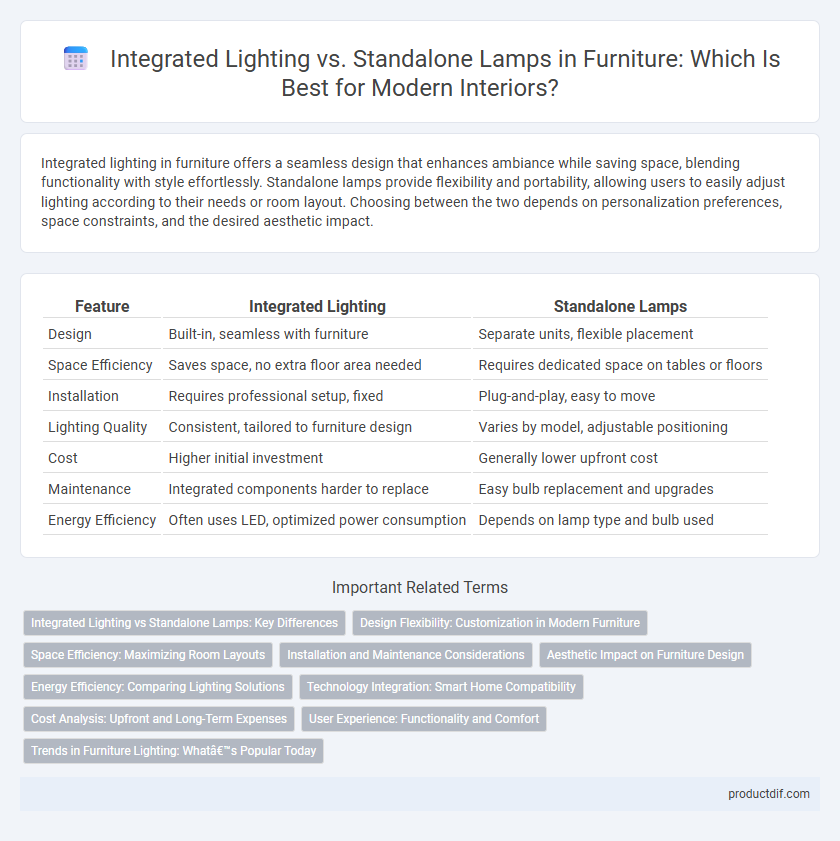Integrated lighting in furniture offers a seamless design that enhances ambiance while saving space, blending functionality with style effortlessly. Standalone lamps provide flexibility and portability, allowing users to easily adjust lighting according to their needs or room layout. Choosing between the two depends on personalization preferences, space constraints, and the desired aesthetic impact.
Table of Comparison
| Feature | Integrated Lighting | Standalone Lamps |
|---|---|---|
| Design | Built-in, seamless with furniture | Separate units, flexible placement |
| Space Efficiency | Saves space, no extra floor area needed | Requires dedicated space on tables or floors |
| Installation | Requires professional setup, fixed | Plug-and-play, easy to move |
| Lighting Quality | Consistent, tailored to furniture design | Varies by model, adjustable positioning |
| Cost | Higher initial investment | Generally lower upfront cost |
| Maintenance | Integrated components harder to replace | Easy bulb replacement and upgrades |
| Energy Efficiency | Often uses LED, optimized power consumption | Depends on lamp type and bulb used |
Integrated Lighting vs Standalone Lamps: Key Differences
Integrated lighting seamlessly combines illumination within furniture pieces, offering a sleek, space-saving solution that enhances ambiance and functionality without additional fixtures. Standalone lamps provide versatile placement and style options, allowing users to easily relocate or replace lighting according to changing design preferences. The key difference lies in integration: integrated lighting is built-in and often custom-designed, while standalone lamps offer flexibility and mobility as separate, independent lighting sources.
Design Flexibility: Customization in Modern Furniture
Integrated lighting in modern furniture offers unparalleled design flexibility by seamlessly blending illumination with structural elements, allowing tailored customization to specific spatial layouts and aesthetic preferences. Standalone lamps provide movable light sources, but lack the cohesive integration, limiting customization to placement rather than built-in design. Furniture with integrated LED strips or embedded fixtures enhances both functionality and visual harmony in contemporary interior design.
Space Efficiency: Maximizing Room Layouts
Integrated lighting enhances space efficiency by embedding light sources directly into furniture pieces like shelves or headboards, reducing the need for additional fixtures. Standalone lamps occupy floor or table space, limiting room layout flexibility and potentially cluttering compact areas. Optimizing furniture with built-in lighting maximizes usable space, enabling cleaner, more functional room designs.
Installation and Maintenance Considerations
Integrated lighting in furniture offers streamlined installation by being built into the design, reducing the need for additional wiring and fixtures, while standalone lamps require separate setup and more flexible placement options. Maintenance for integrated lighting can be more complex, as repairs or replacements often involve disassembling furniture components, whereas standalone lamps allow easy access for bulb changes and cleaning. Choosing between integrated lighting and standalone lamps depends on the desired aesthetic, convenience of maintenance, and the specific lighting needs within the furnished space.
Aesthetic Impact on Furniture Design
Integrated lighting enhances furniture design by creating seamless visual harmony and emphasizing architectural lines, making pieces appear more cohesive and modern. Standalone lamps add versatility and decorative flair, allowing for personalized style changes without altering the furniture itself. Both lighting options significantly influence the ambiance and aesthetic appeal, but integrated systems often elevate the perception of high-end craftsmanship and innovative design.
Energy Efficiency: Comparing Lighting Solutions
Integrated lighting in furniture offers superior energy efficiency by utilizing LED technology directly embedded in design elements, reducing energy consumption by up to 70% compared to standalone lamps. Standalone lamps often rely on less efficient bulbs and require additional power sources, increasing overall energy use. Choosing integrated lighting enhances sustainability and lowers electricity costs without compromising illumination quality.
Technology Integration: Smart Home Compatibility
Integrated lighting systems in furniture offer seamless smart home compatibility by embedding controllable LED lights directly into pieces like beds, desks, and shelves. These systems support advanced technology integration such as app control, voice commands via AI assistants, and customizable color settings, enhancing user convenience and ambiance control. Standalone lamps often provide smart features but lack the cohesive design and spatial efficiency achieved through integrated lighting solutions.
Cost Analysis: Upfront and Long-Term Expenses
Integrated lighting typically requires a higher upfront investment due to built-in electrical components and installation costs, while standalone lamps offer lower initial expenses and flexible placement. Over time, integrated lighting can reduce energy consumption and maintenance costs through energy-efficient LED technology, whereas standalone lamps may incur higher ongoing costs from bulb replacements and less efficient power use. Evaluating total cost of ownership helps determine the more economical option based on usage patterns and budget constraints.
User Experience: Functionality and Comfort
Integrated lighting in furniture enhances user experience by providing seamless illumination that reduces clutter and improves spatial efficiency, creating a more comfortable and functional environment. Standalone lamps offer flexible positioning and easy replacement, allowing users to tailor lighting intensity and direction to personal preferences. Both options balance aesthetics and usability, but integrated lighting often delivers a cleaner design with enhanced convenience for daily activities.
Trends in Furniture Lighting: What’s Popular Today
Integrated lighting in furniture, such as built-in LED strips in shelves and beds, gains popularity for its sleek design and space-saving benefits, blending functionality with modern aesthetics. Standalone lamps remain favored for their versatility and ease of repositioning, often serving as statement pieces in living rooms and bedrooms. Current trends emphasize energy-efficient, customizable lighting options that enhance ambiance while complementing minimalist and smart home interiors.
Integrated lighting vs Standalone lamps Infographic

 productdif.com
productdif.com